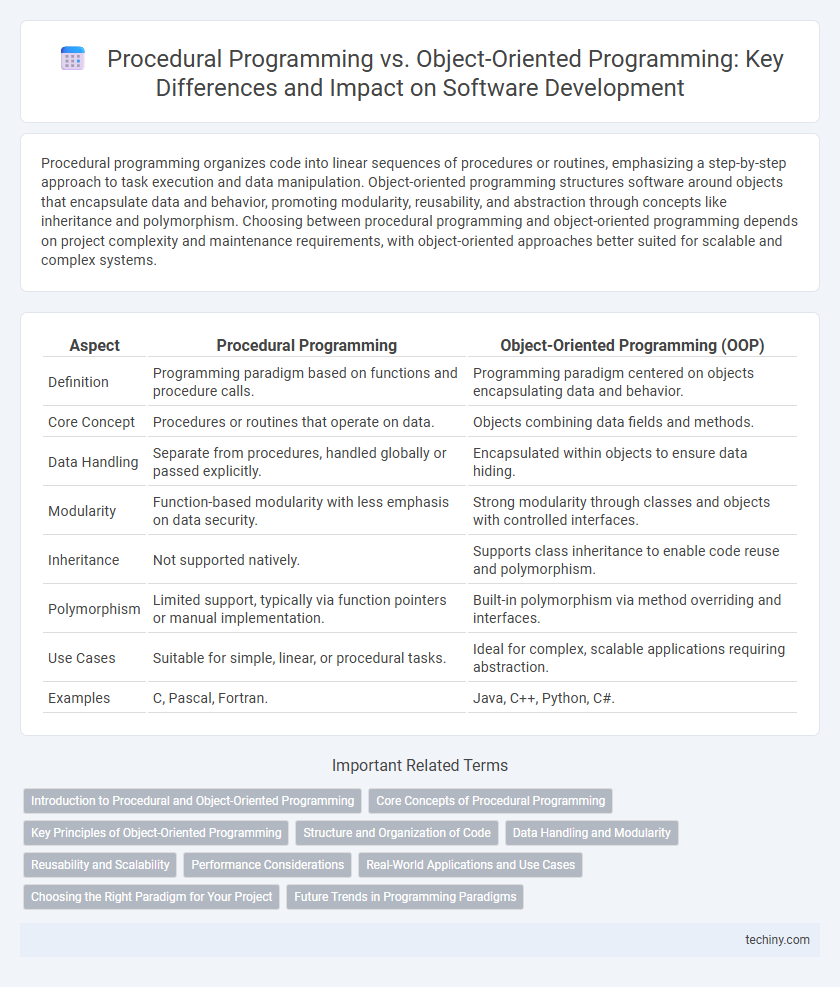Procedural programming organizes code into linear sequences of procedures or routines, emphasizing a step-by-step approach to task execution and data manipulation. Object-oriented programming structures software around objects that encapsulate data and behavior, promoting modularity, reusability, and abstraction through concepts like inheritance and polymorphism. Choosing between procedural programming and object-oriented programming depends on project complexity and maintenance requirements, with object-oriented approaches better suited for scalable and complex systems.
Table of Comparison
| Aspect | Procedural Programming | Object-Oriented Programming (OOP) |
|---|---|---|
| Definition | Programming paradigm based on functions and procedure calls. | Programming paradigm centered on objects encapsulating data and behavior. |
| Core Concept | Procedures or routines that operate on data. | Objects combining data fields and methods. |
| Data Handling | Separate from procedures, handled globally or passed explicitly. | Encapsulated within objects to ensure data hiding. |
| Modularity | Function-based modularity with less emphasis on data security. | Strong modularity through classes and objects with controlled interfaces. |
| Inheritance | Not supported natively. | Supports class inheritance to enable code reuse and polymorphism. |
| Polymorphism | Limited support, typically via function pointers or manual implementation. | Built-in polymorphism via method overriding and interfaces. |
| Use Cases | Suitable for simple, linear, or procedural tasks. | Ideal for complex, scalable applications requiring abstraction. |
| Examples | C, Pascal, Fortran. | Java, C++, Python, C#. |
Introduction to Procedural and Object-Oriented Programming
Procedural programming organizes code into procedures or functions that execute sequential tasks, emphasizing a clear sequence of instructions and data manipulation. Object-oriented programming structures software using objects that encapsulate data and behavior, promoting modularity, reusability, and abstraction through concepts like classes, inheritance, and polymorphism. Understanding these paradigms helps developers choose the best approach for problem-solving and application design based on project requirements and complexity.
Core Concepts of Procedural Programming
Procedural programming centers on a linear top-down approach where programs are divided into procedures or functions that perform specific tasks. It emphasizes the sequence of actions and the manipulation of shared data through variables, relying heavily on control structures like loops and conditionals to dictate program flow. This paradigm facilitates straightforward code organization but often lacks scalability and reusability compared to object-oriented programming.
Key Principles of Object-Oriented Programming
Object-Oriented Programming (OOP) is built on key principles such as encapsulation, inheritance, polymorphism, and abstraction, which promote code reusability and modularity. Encapsulation restricts direct access to some of an object's components, enhancing security and maintainability, while inheritance allows classes to inherit properties and behaviors from parent classes, accelerating development. Polymorphism enables objects to be treated as instances of their parent class rather than their actual class, facilitating flexible and scalable code design.
Structure and Organization of Code
Procedural programming organizes code into linear sequences of instructions and procedures, emphasizing a top-down approach that focuses on functions and step-by-step execution. Object-oriented programming structures code around objects and classes, encapsulating data and behavior to promote modularity, reusability, and maintainability. The object-oriented model facilitates better code organization by grouping related properties and methods, enabling polymorphism and inheritance to streamline complex software development.
Data Handling and Modularity
Procedural Programming organizes code into functions and procedures that operate on data, promoting straightforward data handling but often leading to less modular, tightly coupled code. Object-Oriented Programming encapsulates data and behavior within objects, enhancing modularity by allowing data hiding, inheritance, and polymorphism for better code reuse and maintainability. This encapsulation in OOP improves data integrity and supports scalable software architectures compared to the linear data manipulation typical of procedural approaches.
Reusability and Scalability
Procedural programming emphasizes linear, function-driven code, which can limit reusability due to tight coupling of procedures and data structures. Object-oriented programming enhances reusability by encapsulating data and behaviors into objects, allowing inheritance and polymorphism to promote modular, maintainable code. Scalability improves in OOP through design patterns and abstraction layers that facilitate code extension and modification without impacting existing functionality.
Performance Considerations
Procedural programming often delivers faster execution speeds due to its straightforward, linear flow and lower overhead, making it well-suited for performance-critical applications. Object-oriented programming introduces abstraction layers and dynamic dispatch, which can increase runtime overhead and memory usage, potentially impacting performance. Optimizing object-oriented designs with techniques like just-in-time compilation, efficient memory management, and minimizing inheritance depth can mitigate these performance costs.
Real-World Applications and Use Cases
Procedural programming excels in tasks requiring straightforward, linear workflows such as scripting, system utilities, and batch processing, especially in applications like database management and embedded systems. Object-oriented programming is favored in complex software projects like enterprise applications, game development, and GUI-based systems due to its modularity, reusability, and ease of maintenance. Real-world use cases of OOP include frameworks like Java Spring for web applications, while procedural approaches remain prevalent in legacy C programs and small-scale automation scripts.
Choosing the Right Paradigm for Your Project
Choosing the right programming paradigm depends on the project's complexity and scalability requirements. Procedural programming suits straightforward, linear tasks with clear sequences of instructions, while object-oriented programming excels in managing complex systems through encapsulation, inheritance, and polymorphism. Evaluating factors such as code maintainability, team expertise, and future expansion will guide the decision between procedural and object-oriented approaches.
Future Trends in Programming Paradigms
Procedural programming, characterized by linear code execution and function calls, remains efficient for simple, task-driven applications, while object-oriented programming (OOP) enhances modularity and reusability through encapsulation and inheritance. Future programming paradigms increasingly integrate functional and declarative styles with OOP to address scalability and concurrency in complex software systems. Emerging trends emphasize adaptive, AI-driven code generation and domain-specific languages to optimize performance and maintainability across diverse development environments.
Procedural Programming vs Object-Oriented Programming Infographic

 techiny.com
techiny.com